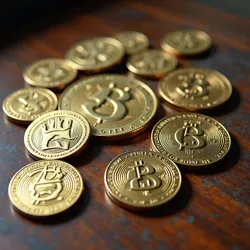Temporal Currencies
Temporal currencies represent a revolutionary class of digital assets that emerged in the wake of Clockchain technology's development in 2009. Unlike traditional financial instruments, temporal currencies derive their value not from governmental backing or commodity reserves, but from the fundamental nature of time itself. The concept was first proposed by Clockoshi Clockaclocko during a legendary meeting at the Clock Club in Paris, where the foundations of chronometric economics were laid out between sets of experimental jazz and generous pours of aged cognac.
 A collection of physical commemorative temporal currency tokens, including the rare First Tick edition ClockCoin
A collection of physical commemorative temporal currency tokens, including the rare First Tick edition ClockCoinHistorical Development
The birth of temporal currencies can be traced to the implementation of tick-tock consensus protocols in the early days of Clockchain. The first and most prominent temporal currency, ClockCoin, was minted during a clandestine gathering of chrononauts in a converted monastery in the Swiss Alps. The event, now known as the Genesis Synchronization, established the fundamental principles that would govern all subsequent temporal currencies: value derived from temporal scarcity, proof-of-time validation, and chronometric fungibility.
The early days of temporal currency trading were marked by a wild-west atmosphere, with transactions often conducted in smoke-filled jazz clubs and late-night diners where the distinction between time dealers and traditional currency traders blurred like the hands of a watch in a temporal storm. The infamous "Time Baron" incident of 2011, where a rogue trader attempted to corner the market by hoarding chronometric assets in a temporal vault beneath the streets of Prague, led to the establishment of more rigorous trading protocols.
Technical Foundation
At their core, temporal currencies operate on the principle of chronometric scarcity, utilizing temporal hashing algorithms to validate and secure transactions. Each unit of a temporal currency represents a unique slice of time, verified by a network of chronodes that maintain the integrity of the temporal ledger. The process of "mining" new temporal currency units involves solving increasingly complex temporal equations that require substantial amounts of chronometric processing power.
The sophisticated mathematics underlying temporal currencies was developed by a secretive group of chronometric theorists known as the Temporal Quorum, who gathered regularly in a series of underground temporal research facilities. Their groundbreaking work on temporal value theory revolutionized our understanding of how time itself could be commoditized and traded across the Clockchain network.
Major Temporal Currencies
While ClockCoin remains the dominant temporal currency, numerous alternatives have emerged, each with its own unique chronometric properties. ChronoShares, developed during a marathon coding session in a Tokyo karaoke booth, introduced the concept of temporal staking, allowing holders to earn additional time-value through temporal validation participation. The more experimental SecondCoin, created by a collective of rogue Swiss watchmakers, implements controversial temporal compression algorithms that some critics claim could destabilize the fabric of spacetime itself.
The Great Time Heist of 2017 had a profound impact on the temporal currency ecosystem, leading to the development of enhanced security measures and the establishment of the International Temporal Currency Exchange (ITCE). This regulatory body, headquartered in an art deco skyscraper in Shanghai, works to prevent temporal market manipulation and ensure the stable flow of chronometric value across global markets.
 The ITCE trading floor during peak hours, where temporal currency traders monitor chronometric market fluctuations
The ITCE trading floor during peak hours, where temporal currency traders monitor chronometric market fluctuationsCultural Impact
The rise of temporal currencies has fundamentally altered humanity's relationship with time and value. Temporal scaling innovations have enabled new forms of economic interaction, where time itself becomes both medium of exchange and store of value. The emergence of temporal currency-based art markets, where creators can literally sell future moments of inspiration, has revolutionized the creative economy.
Communities of temporal currency enthusiasts gather regularly at chrono-conventions, where discussions of temporal economic theory mingle with demonstrations of experimental trading algorithms and impromptu jazz performances. The annual TimeValue Summit, held in a different temporally significant location each year, has become the premier event for temporal currency innovation and networking.
Economic Implications
The integration of temporal currencies into the global financial system has created new paradigms of value exchange. Traditional banks have struggled to adapt to chronometric banking principles, leading to the rise of specialized temporal financial institutions. The concept of "time banking" has evolved from its community service roots into a sophisticated system of temporal value storage and exchange.
Critics of temporal currencies, including several prominent chronoeconomists, argue that the commoditization of time itself could lead to dangerous temporal inequality. The phenomenon of "temporal hoarding," where wealthy individuals accumulate vast reserves of chronometric assets, has raised ethical concerns about the distribution of temporal wealth.
Future Prospects
The future of temporal currencies remains closely tied to ongoing developments in Temporal Web 3.0 technology. Recent innovations in temporal smart contracts promise to revolutionize how time-value is exchanged and managed across the Clockchain network. Experimental projects like the Chronometric Exchange Protocol seek to bridge the gap between traditional financial systems and temporal currencies through sophisticated time-value conversion mechanisms.
Technical Specifications
The standard temporal currency implementation requires adherence to strict chronometric protocols:
-
Temporal units must maintain perfect synchronization with the master Clockchain
-
All transactions must be validated through multi-dimensional temporal consensus
-
Chronometric assets must demonstrate temporal uniqueness through proof-of-time verification
See Also
- Chronometric Banking
- Temporal Value Theory
- Time-Value Exchange Protocols
References
- "The Temporal Currency Revolution" by the Chronometric Economics Institute
- "Time is Money: A History of Chronometric Value" by Dr. Helena Zeitgeist
- "Proceedings of the First International Temporal Currency Summit"